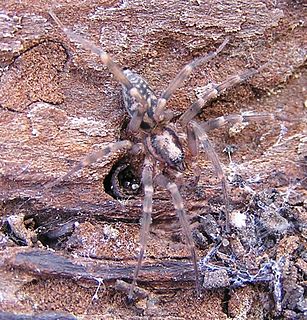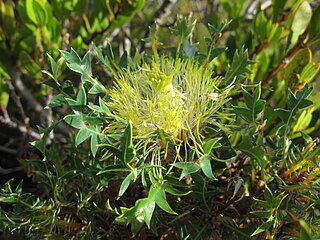
Liocranidae is a family of araneomorph spiders first described by Eugène Simon in 1897. They are one of several groups called "sac spiders". The holarctic genus Agroeca is the best-known, but it also includes various genera of more obscure spiders that still lack a diagnosis. Two species in the North American genus Neoanagraphis are found in the extremely dry conditions in the Mojave, Sonoran and Chihuahuan deserts. Females live in animal burrows while males wander and are the ones most often caught in pitfall traps.
Pacullidae is a family of araneomorph spiders first described by Eugène Simon in 1894. It was merged into Tetrablemmidae in 1958, then raised back to family status after a large phylogenetic study in 2017.

The Chilean angelshark is an angelshark of the family Squatinidae found in the subtropical waters of Chile, that grows up to 1.03 metres in length. The holotype is lost. Reproduction is ovoviviparous.

Banksia armata, commonly known as prickly dryandra, is a species of often sprawling shrub that is endemic to Western Australia. It has deeply serrated leaves with sharply pointed lobes and spikes of about 45 to 70 yellow flowers.

Banksia armata var. armata is a variety of shrub that is endemic to Western Australia. It differs from the other variety in having a lignotuber, narrower leaves with more sides lobes and shorter flowers. It is also usually a shorter plant.

Banksia armata var. ignicida is a variety of shrub that is endemic to Western Australia. It differs from the autonym in not having a lignotuber. It is also usually a taller plant with leaves that are longer with fewer side lobes, and longer flowers.

Dryandra subg. Dryandra is an obsolete clade of plant. It was a series within the former genus Dryandra. The name was first published at sectional rank as Dryandra verae in 1830, before being renamed Eudryandra in 1847, the replaced by the autonym at subgenus rank in 1996. It was ultimately discarded in 2007 when Austin Mast and Kevin Thiele sunk Dryandra into Banksia.

Dryandra ser. Armatae is an obsolete series within the former genus Dryandra. It was first published by George Bentham in 1870, and was given a new circumscription by Alex George in 1996, but was ultimately discarded in 2007 when Austin Mast and Kevin Thiele sunk Dryandra into Banksia.

Pisa armata is a species of crab from the eastern Atlantic Ocean.
Dictyna armata is spider species found in Ukraine and Georgia.
Koppe is a genus of liocranid sac spiders first described by Christa L. Deeleman-Reinhold in 2001.
Tetragnatha armata, is a species of spider of the genus Tetragnatha. It is endemic to Sri Lanka.
Prodysderina is a genus of spiders in the family Oonopidae. It was first described in 2013 by Platnick et al.. As of 2017, it contains 9 species.

Euprosthenopsis is a genus of African nursery web spiders that was first described by P. Blandin in 1974.
Zornella is a genus of sheet weavers that was first described by A. R. Jackson in 1932. As of June 2019 it contains only three species, found in Asia, Siberia, Canada, and the United States: Z. armata, Z. cryptodon, and Z. cultrigera.
Obatala is a genus of African tangled nest spiders containing the single species, Obatala armata. It was first described by Pekka T. Lehtinen in 1967, and has only been found in South Africa.
Thyenula armata is a jumping spider species in the genus Thyenula that lives in South Africa and Lesotho. It was first described by Wanda Wesołowska in 2001.
Zornella armata is a species of dwarf spider in the family Linyphiidae. It is found in the United States and Canada.







